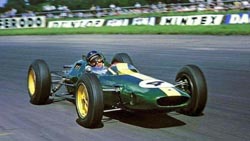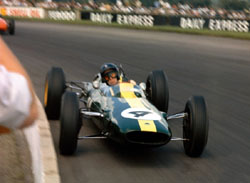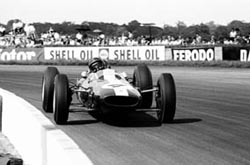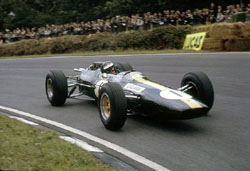In the world of F1, 1961 saw the engine capacity of the cars reduced to 1.5 liters, fuel regulations were also changed and now required engines to run on 101.5 octane fuel instead of the 130 octane Avgas. These changes seemed to have a negative effect on the British teams compared to other manufacturers who seemed down on power compared to the likes of Ferrari.
In 1962 Lotus would find an answer with the Lotus 25. Mid-engined cars were standard and the Lotus 25 was not the first racing car with a monocoque chassis but its artistic simplicity and immense success in the hands of Jim Clark revolutionized Grand Prix racing car design. Colin Chapman experimented with a backbone chassis on the Lotus Elan sports car and decided to apply the same techniques to a single-seater racing car. Using box-sections he built a tub wide enough for a driver and within would go rubber bags to hold fuel. The driver would now sit in an almost reclining position that took some getting used to for Clark, in fact it took a brave man indeed to drive one of these cars at full speed.
The main benefits of this design were increased torsional rigidity and less weight and with a smaller frontal area. The resulting stiffness allowed Lotus to use more supple suspension which offered great advantages in slower, tighter turns. This car only further added to the reputation that Colin Chapman was known as an instinctive seat of the pants designer. In fact when the first prototype was being built he took the opportunity of sitting in the car. To his surprise he found that he could fit quite comfortably and announced forthright that: "This cockpit's too wide ... take another inch and a half out out of it!" Dick Scammell, one of the mechanics that built the first car would later remark that: "None of us really knew what we were doing, but it all took shape very nicely and it certainly looked right."
Power was again provided by Coventry-Climax, the fire pump manufacturer. Costing £3000 per motor the investment paid off and finally resulted in Ferrari's advantage being bridged. The car was fast straight out of the box and when it finished it won. In 1963, Engineer Len Terry returned to Lotus and worked to improve the cars reliability. His work bore fruit the very next year - 1963, when Jimmy Clark won a then record seven races and the World Championship.
This was an extremely enjoyable build which was vastly improved by the Thunder Valley F1 detail kit, specifically designed for the model, there were enough parts left over for me to complete a 1962 variant of the car which I will do at a later date.
 |
| Click above for build and completed pictures |
|
|
 |
| Jim Clark - 1962 British GP |
 |
| Jim Clark - 1962 British GP |
 |
| Jim Clark - 1962 British GP |
 |
| Jim Clark - 1963 Brands Hatch |
|



